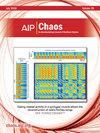一种新型油藏计算模型中的高阶相互作用、自适应和相变。
IF 3.2
2区 数学
Q1 MATHEMATICS, APPLIED
引用次数: 0
摘要
我们提出了一种新的储层神经网络模型,该模型结合了脑神经系统的关键特性,包括自适应性,单元之间的高阶相互作用,以及允许“混沌边缘计算”的相变的存在。该网络的性能在基准机器学习任务上进行了评估,例如再现多维周期模式和预测混沌洛伦兹吸引子的动态。我们的研究结果表明,元件间耦合主要有助于产生目标输出。此外,我们证明了在学习之后会发生一个新的相变,使得相的动力学与初始相不同。本文章由计算机程序翻译,如有差异,请以英文原文为准。
Higher-order interactions, adaptivity, and phase transitions in a novel reservoir computing model.
We propose a novel reservoir neural network model that incorporates key properties of brain neural ensembles, including adaptivity, higher-order interactions among units, and the presence of a phase transition, which allows "edge-of-chaos computations." The network's performance was evaluated on benchmark machine learning tasks, such as reproducing multidimensional periodic patterns and predicting the dynamics of the chaotic Lorenz attractor. Our findings indicate that interelement couplings primarily contribute to generating the target output. Furthermore, we demonstrate that a new phase transition occurs after learning, such that the dynamics of the phases become different from the initial.
求助全文
通过发布文献求助,成功后即可免费获取论文全文。
去求助
来源期刊

Chaos
物理-物理:数学物理
CiteScore
5.20
自引率
13.80%
发文量
448
审稿时长
2.3 months
期刊介绍:
Chaos: An Interdisciplinary Journal of Nonlinear Science is a peer-reviewed journal devoted to increasing the understanding of nonlinear phenomena and describing the manifestations in a manner comprehensible to researchers from a broad spectrum of disciplines.
 求助内容:
求助内容: 应助结果提醒方式:
应助结果提醒方式:


